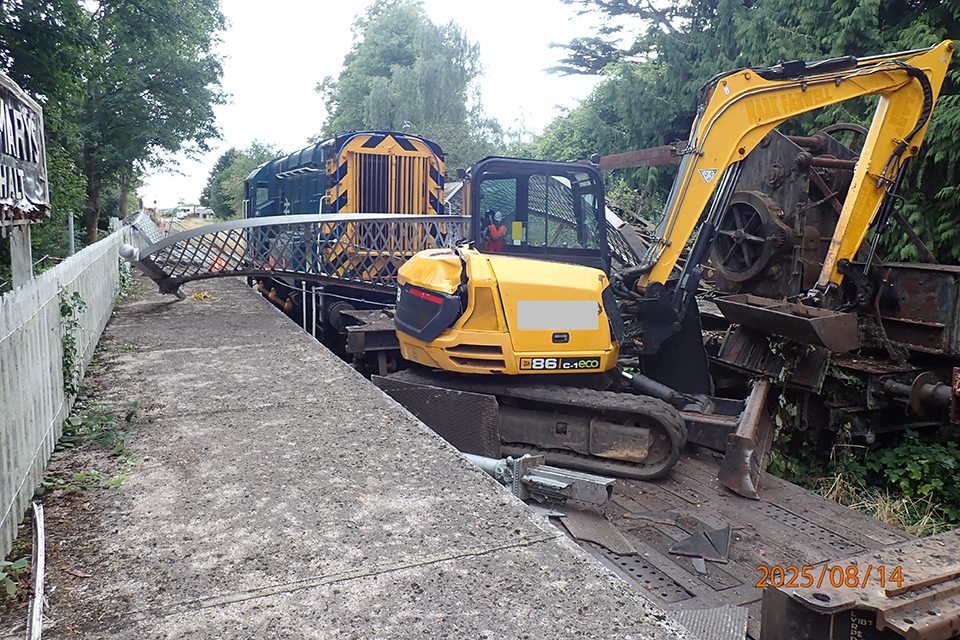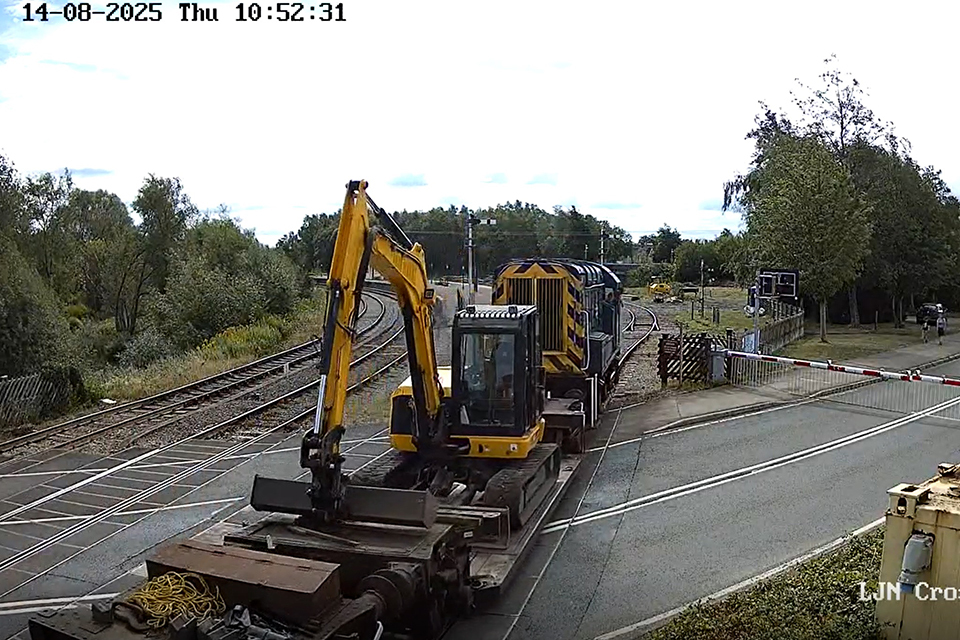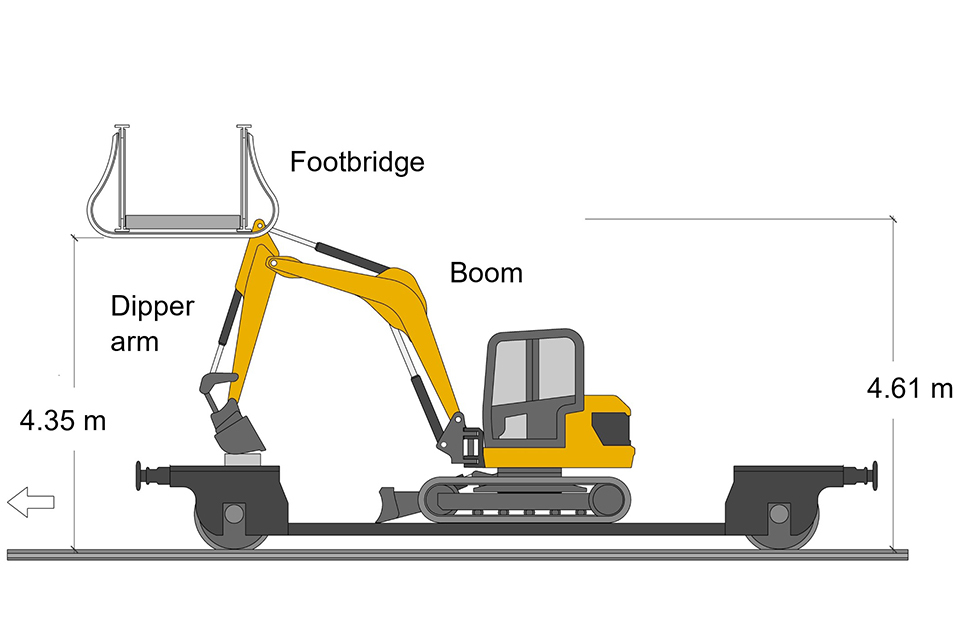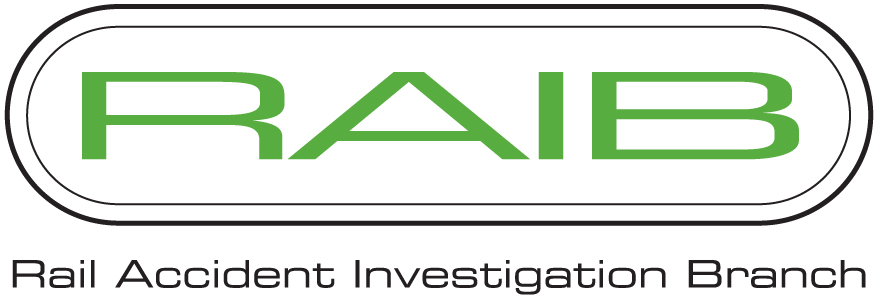Collision of train load with a footbridge on Dean Forest Railway, 14 August 2025
Published 26 November 2025
1. Important safety messages
This accident demonstrates the importance of heritage railway staff and volunteers:
- only undertaking safety-critical tasks for which they have been trained and assessed as competent
- being aware of any loading gauge restrictions when transporting large or unusual loads by train.
This accident also underlines the importance of heritage railways undertaking appropriate risk assessments for their activities and implementing effective controls.
2. Summary of the accident
At around 10:55 on Thursday 14 August 2025, part of a 360-degree excavator being transported on a train struck the footbridge which carries a public footpath over the Dean Forest Railway at St Mary’s Halt station, Lydney, Gloucestershire. The train was travelling at around 10 mph (16 km/h) when the accident occurred. The footbridge collapsed as a result of the collision, with parts of it falling onto the station platform and the moving train.
There were no injuries caused by the accident. No pedestrians were using the footbridge when the accident occurred, and the railway was not open to the public.
The train, operated by Dean Forest Railway volunteer staff, was transporting an excavator owned by the railway from Lydney Junction to Whitecroft, a distance of around 3 miles. The train consisted of a class 08 diesel-electric shunting locomotive propelling two 4-wheel well wagons and a bogie brake van, which was at the leading end. The excavator was on the wagon nearest the locomotive, but the train driver was unable to see it as the locomotive’s driving cab was at the rear.
The brake van was carrying six volunteers, including a shunter who was riding on the leading veranda. The shunter was responsible for keeping a lookout and giving movement instructions to the driver by radio. When the shunter heard a loud bang, they immediately instructed the driver to stop.

Accident scene looking towards rear of train.
3. Cause of the accident
The accident occurred because the 360-degree excavator was stowed on the wagon with its bucket resting on the wagon’s raised front deck. This increased the excavator’s overall height and meant that the upper part of its dipper arm, attached to the boom, was too high to pass under the footbridge.
The Dean Forest Railway is a 4.2 mile (6.8 km) long heritage railway that runs between Lydney and Parkend in the Forest of Dean. The Dean Forest Railway was established in 1970 and started operations in 1971. It is operated by paid staff and volunteers.
The lattice girder footbridge at St Mary’s Halt was opened in 1892 and constructed of wrought iron beams supported on cast iron columns. It spanned the tracks and platform and carried a public footpath providing access to a lake and a residential area. In 2022, following refurbishment, the height of the underside of the bridge was measured at 4.35 metres above rail level.
The railway owns three ‘Loriot’ well wagons which were built by British Railways in the 1950s. This type of wagon has a carrying capacity of 20 tonnes and was designed for transporting plant and machinery on a lowered central deck situated between the wheels. When carrying the type of excavator involved in the accident, the lower deck sits 0.36 metres above rail level. The upper deck is 0.8 metres above the lower deck.
The railway also owns two 360-degree excavators. These are a 6-tonne excavator purchased in 2009 and an 8-tonne excavator purchased in 2024. Some railway staff and volunteers had passed an external accredited training course to operate the excavators. This course included both theoretical and practical tests. The Dean Forest Railway maintains a list of qualified excavator operators.
Qualified operators require additional railway-specific training for loading, unloading, and stowage of an excavator on a rail wagon. This training was undertaken with the smaller 6-tonne excavator, but emphasised that, when stowing an excavator on a Loriot wagon, the bucket should rest on the lower deck. This requirement was not recorded as a written instruction. The 6-tonne excavator was regularly moved up and down the railway by train to undertake maintenance tasks, but the 8-tonne excavator was moved less often.
The task of moving the 8-tonne excavator on 14 August 2025 required a qualified excavator operator (excavator operator 1) to load the excavator onto the wagon at Lydney Junction and off-load it at Whitecroft. When excavator operator 1 was delayed, another volunteer (excavator operator 2) was asked by a railway manager if they would be willing to load the excavator. Excavator operator 2 agreed to this.
Excavator operator 2 had some experience operating the 6-tonne excavator and had passed an external excavator operator’s theory test in 2022. At that time, they had insufficient practical experience to pass the practical test. This meant that they did not become a qualified excavator operator and did not progress further. This also meant that they did not attend additional training arranged by the railway to cover loading and unloading an excavator from a rail wagon.
Despite not being qualified in the role, excavator operator 2 had previously loaded and unloaded the 6-tonne excavator from a Loriot wagon on several occasions. After loading, they always rested the bucket on the raised deck at the end of the wagon and this excavator, which is smaller than the 8-tonne excavator, would remain within loading gauge (maximum permitted height) in this configuration. Excavator operator 2 had once off-loaded the 8-tonne excavator from a wagon, about 5 months previously, but had never loaded the larger excavator onto a wagon before.
Excavator operator 2 loaded the 8-tonne excavator onto the wagon and stowed it with its bucket resting on the raised upper deck at the front, as they had previously done with the 6-tonne excavator. During the loading, the train driver and shunter went to inspect a different wagon in another part of the station yard and did not witness the loading activity. There was no requirement for the driver or shunter to check the load before the train departed and there is no equipment to allow out-of-gauge loads to be detected at Lydney Junction.

CCTV image showing incident train travelling towards the camera near Lydney Junction station, shortly before the accident (courtesy of Dean Forest Railway).
Following the accident, a reconstruction showed that the top of the 8-tonne excavator’s dipper arm was 4.61 metres above rail level when the accident occurred. This meant it was 0.26 metres higher than the underside of the footbridge, making a collision inevitable.

Diagram showing actual height of 8-tonne excavator compared with footbridge.
Post-accident testing also showed that the 8-tonne excavator could be positioned on the wagon, so the highest part of the boom was 3.12 metres above rail level.

Diagram showing 8-tonne excavator correctly loaded.
Therefore, the 8-tonne excavator had been loaded onto the wagon by a volunteer member of staff who was not qualified to operate it, and who had not received the specified training for loading excavators onto wagons. The railway also did not have a written instruction to indicate the correct location for an excavator’s bucket when stowed on a Loriot wagon. Its generic risk assessment relating to digger operation, prepared in 2010 and reviewed in 2013, 2014 and 2016, did not address transporting an excavator by train.
In addition, since acquiring the 8-tonne excavator in 2024, Dean Forest Railway had not checked its loading gauge against structures on the railway, including the footbridges at St Mary’s Halt and at Parkend station. This risk was intended to be managed by training operators to correctly stow the bucket on the lower deck.
There was also no method, or requirement, for staff or volunteers to check the height of loads on trains departing Lydney Junction which meant that out-of-gauge loads could not be identified.
4. Previous similar occurrences
RAIB’s investigation into the 2014 runaway and subsequent collision near to Loughborough Central station (RAIB report 04/2015) made a learning point that safety-critical activities (such as the movement, shunting and stabling of trains) on heritage railways must be undertaken by an adequate number of staff holding the correct competencies.

